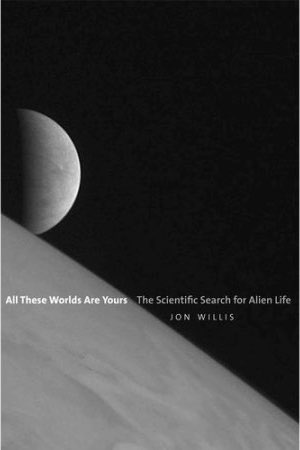Review: All These Worlds Are Yoursby Jeff Foust
|
| The book offers a concise overview of astrobiology and what we know—and, more importantly, what we don’t—about the search for life elsewhere in our solar system and beyond. |
Of course, there’s precious little evidence that the planet is, in fact, like the Earth to a significant degree. While the planet orbits as a distance where its surface temperature would allow liquid water to exist, there’s been no detection of water of any kind, nor of any atmosphere that may or may not be conducive to life. The planet’s exact mass isn’t even known: the radial velocity technique used to discover it sets only a minimum value, and the planet could be significantly heavier depending on the inclination of that solar system as seen from Earth. There’s also the fact that Proxima Centauri is an active star that frequently flares, making the planet less hospitable for life. A promising discovery, to be certain, but there’s a long way to go before scientists can declare “Proxima b” to be seriously Earth-like.
Within the few days of the announcement of Proxima b came word of an “interesting” signal reportedly detected by a Russian radio telescope. The signal was detected last May from HD 164595, a Sun-like star 95 light-years away around which astronomers had already discovered one planet. This attracted the attention of the small Search for Extraterrestrial Intelligence (SETI) community, and soon the public after the inevitable “astronomers detect alien signal” stories.
Except, of course, there was no alien signal. Within days Russian officials said that the detection last year—curiously not reported for more than a year—was simply terrestrial interference, and followup observations by others turned up nothing. Move along, folks, nothing to see, or hear, here.
A useful curative to that coverage is the new book All These Worlds Are Yours. Jon Willis, an astronomy professor at the University of Victoria in Canada who teaches astrobiology, offers a concise overview of astrobiology and what we know—and, more importantly, what we don’t—about the search for life elsewhere in our solar system and beyond.
Given the interdisciplinary nature of astrobiology, much of the first part of the book is an overview of the current state of knowledge in several different fields, from the formation of the universe to the development of life on Earth. It’s a useful explanation of why life could be relatively common in the universe, but also not easy to detect.
| “Basic life will not wave to our passing spacecraft and peering telescopes,” he writes. “Instead, we will be offered mysteries, anomalies, things that don’t add up.” |
Willis devotes much of the book examining five cases—a combination of specific destinations and more general search techniques—for finding life beyond Earth. There’s Mars, with tantalizing evidence that it was at least hospitable to life in its past. Europa and Enceladus, the icy moons of Jupiter and Saturn, respectively, that have liquid water oceans beneath their icy surfaces, are linked together in one chapter. Titan, the moon of Saturn with a thick atmosphere and liquid hydrocarbon seas, is considered as a possible abode of life that can operate at much colder temperatures than found on Earth. Exoplanets get their own chapter, as Willis discusses the challenges of trying to detect evidence of life on those distance worlds. Finally, SETI gets discussed as a kind of low-probability, high-payoff technique.
Throughout the discussion in the book, Willis pits the different destinations and approaches against one another, in a sense: he asks the reader how they would spend a hypothetical $4 billion astrobiology budget (an amount, he said, he chose because it’s the amount spent globally each day on defense) on ways that might best answer the question of if and where life exists beyond Earth. Do you go all-in on Mars or Europa, for example, or make more investments on exoplanet studies? Willis discloses at the end of the book he would prefer spending much of that $4 billion on a mission to Enceladus, collecting samples of its subsurface ocean expelled into space by plumes for return to Earth. But the message is clear: the search for life requires tough choices given the likely resources available for the effort.
There’s another message in All These Worlds Are Yours as well: finding life beyond Earth won’t be easy. “Basic life will not wave to our passing spacecraft and peering telescopes,” he writes. “Instead, we will be offered mysteries, anomalies, things that don’t add up.” It’s worth adding that some of those mysteries and anomalies may be evidence of life, others simply curious phenomena that have nothing to do with life, and yet others instrument error or interference. That’s a lesson worth remembering the next time you read about the discovery of an interesting alien signal or an Earth-like exoplanet.
